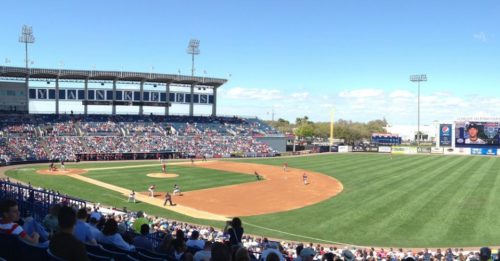Iowa winters are longer and colder than the ones I remember growing up in southern Indiana. Finishing up February, we need something to look forward to. For baseball fans, that’s easy. The latter half of February reliably brings us the first spring training games.
Anyone on a trip to Florida or Arizona with 5 bucks in their pocket can see major league baseball players preparing for the upcoming season. The players are shaking off the rust, working on a new swing, or rehabbing a surgically-repaired arm. Even those of us still in Iowa can read about it and dream about what’s on the horizon – baseball and warmer days.
Spring training is a consolation in a cold, dark season. And, of course, it marks the beginning of a new one.
William Zinsser’s Spring Training
Many people know William Zinsser from his wildly successful book On Writing Well, an essential resource for new writers. But he wrote about a wide range of topics, including baseball’s spring training.
Zinsser visited the Pittsburgh Pirates spring training facilities in Florida in early 1988. The Pirates concluded a promising 1987 season at the end of a rebuilding period. Entering 1988, they were a team of young players ready to find their first success. Zinsser tagged along, hoping to watch a young team come to life.
Young players are often the most receptive to coaching. But even players in their early 20s enter with the baggage of long baseball careers. Little League coaches, high school coaches, college coaches, intramural coaches, minor league coaches, et al. Often coaches from two or three (or more) professional organizations. How do major league coaches navigate this sea of advice, tips, and secrets?
Interviews
I enjoyed Zinsser’s interviews with managers, players, and umpires. He interviewed a young Jim Leyland, Pirates manager through the late 1980s and early 1990s. Leyland was near the beginning of his managerial career in 1988. Much later, he won a World Series title with the Florida Marlins and finished his career with the Detroit Tigers. Zinsser interviewed a young Barry Bonds, long before the home runs and the steroid controversies that would dog his career.
But the better interviews were with those at the margins of the game. He found out that umpires go through a spring training of their own, jockeying for status and the right to move from the minor leagues to the major leagues. And he tracked down an old Hall of Famer named Edd Roush living in the town where the Pirates hold spring training, interviewing him only a few weeks before his death.
One reason I picked up the book is that I was hoping to find an interview with Doug Drabek, a distant cousin I’ve written about before. In 1988, Drabek was a 25 year old pitcher for the Pirates. And he was exactly the sort of young player Zinsser might focus on in a book about spring training. Drabek ended up being very important to the Pirates over the next five seasons. But, alas, no interview. Zinsser does mention him a few times.
Yankees Spring Training and 2020 Season
And, finally, there’s the Yankees. How are they doing heading into 2020 spring training?
Not bad so far! The Yankees were a great team in 2019, and didn’t have too many roster spots to fill. They needed a top notch starting pitcher, and they signed one in Gerrit Cole. In addition, they resigned Brett Gardner for outfield depth at a bargain price.
On the other side of the ledger, they lost Dellin Betances, Edwin Encarnación, and Didi Gregorius to free agency. Encarnación and Gregorius are fine players, but the Yankees have plenty of options at SS and 1B/DH. The loss of Betances stings a bit more – he’s a very solid late inning reliever – but the Yankees have a great bullpen without him.
There’s plenty of reason for optimism that the Yankees can improve on their very good 2019.
